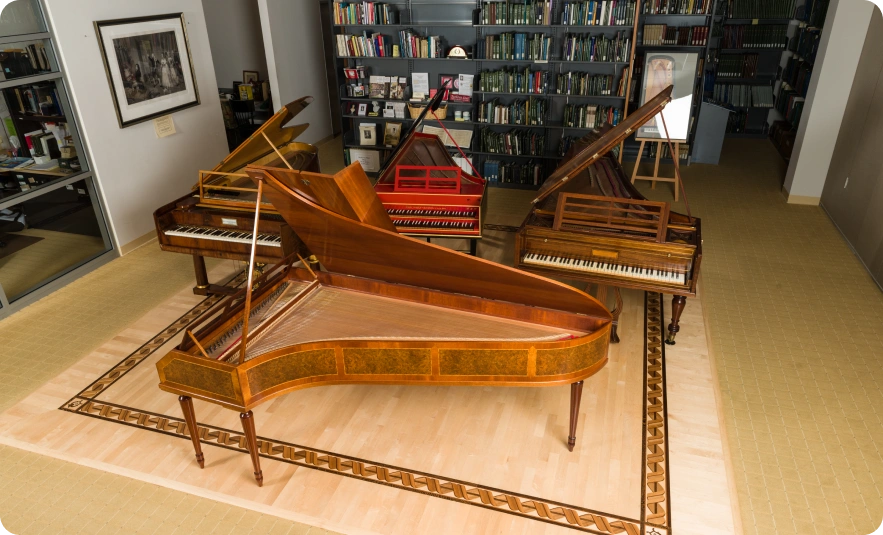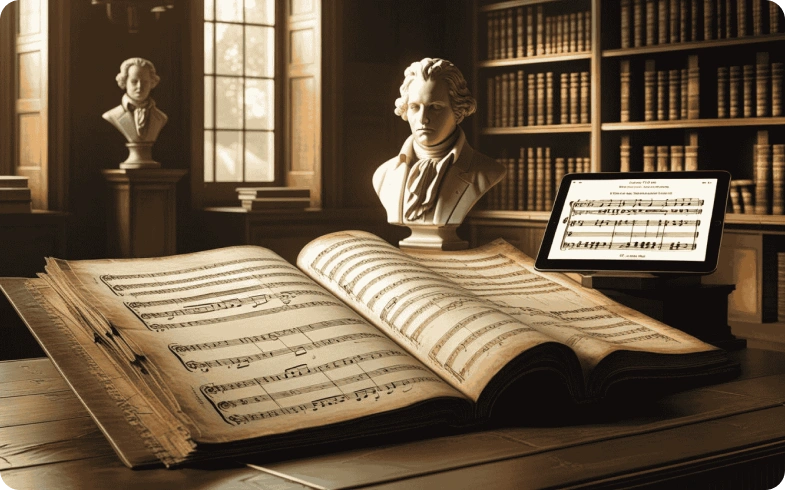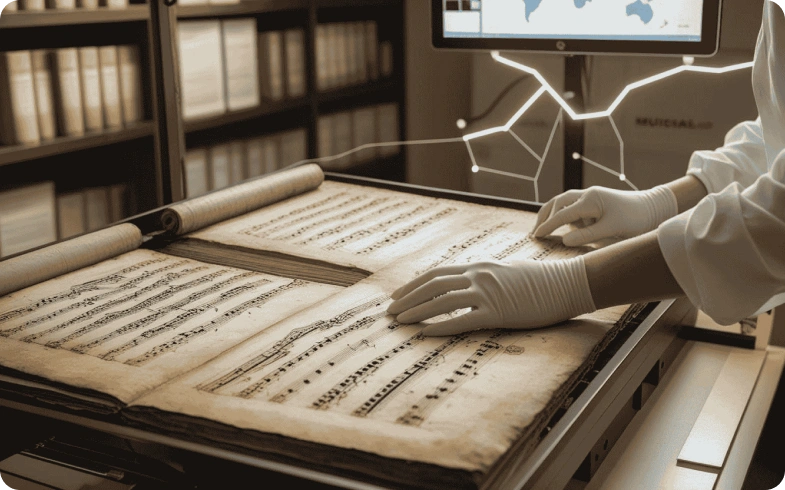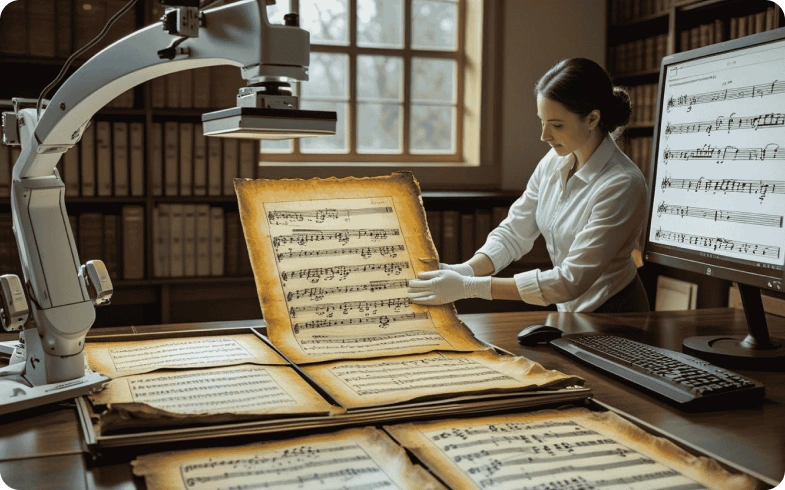
eRecordsUSA Digitized Rare Beethoven Manuscripts for SJSU’s Ira F. Brilliant Center
The Ira F. Brilliant Center for Beethoven Studies, located within San José State University, houses one of the most extensive collections dedicated to composer Ludwig van Beethoven.
To enhance global accessibility and preserve delicate materials, the Center initiated a digitization project focusing on rare scores and manuscripts. eRecordsUSA was given this big task, and we treated the delicate materials with the attention they deserved.
Utilizing advanced document scanning technologies, eRecordsUSA converted approximately 42,000 pages of fragile, bound, and unbound volumes of music scores into high-resolution files. This initiative safeguards the physical documents and books and supports academic research and public engagement worldwide.
Project Profile
- Client: Ira F. Brilliant Center for Beethoven Studies, San José State University
- Location: Beethoven Center, San Jose State University, One Washington Square, San Jose, CA 95192-0171
- Industry: Academic / Archival / Musicology / Rare & Delicate Records
- Document Types: Collected bound editions of Beethoven's piano sonatas, rare & historical music scores, and manuscripts
- Volume: Approximately 42,000 large-format bound book pages
- Primary Goal: Digitize and preserve rare large-sized music books & bound music scores to minimize physical handling while enhancing accessibility for global academic use
Challenges
- Fragile Materials: The collection included large-format bound volumes of music scores and manuscripts in deteriorated condition, requiring non-destructive & preservation-level handling and digitization methods.
- Volume and Complexity: Approximately 42,000 pages needed to be digitized, many of which contained intricate musical notations.
- Metadata Integration: Ensuring digitized files were accurately tagged and organized for seamless integration into SJSU's digital collections platform.
- Time Constraints: Completing the project within the specified timeframe without compromising quality.
- Educational Reach: Designing the output in formats accessible for educators, students, and researchers across disciplines.
Solution
- Non-Destructive Scanning: Employed overhead V cradle scanners to digitize bound volumes without disbinding or damaging, preserving the original structure.
- High-Resolution Imaging: Captured images at up to 400 DPI to ensure clarity of musical notations and annotations.
- Metadata Tagging: Applied detailed metadata to facilitate educational use and research navigation.
- Quality Assurance: Implemented rigorous QA protocols to maintain the integrity and accuracy of digitized content.
- Educational Structuring: Output designed for integration into syllabi, research databases, and digital learning environments.
Who is Ludwig van Beethoven, and Why Does His Legacy Still Matter?
Ludwig van Beethoven (1770–1827) was a German composer and pianist whose work profoundly reshaped the landscape of Western classical music.
Bridging the Classical and Romantic eras, Beethoven’s compositions are revered for their technical mastery, emotional depth, and innovation. His music has influenced generations of composers and remains a cornerstone of music education, performance, and scholarship.
“Beethoven’s music transcends time. It teaches resilience, complexity, and emotional intelligence—qualities that are as vital to today’s students as they were two centuries ago.”

Enduring Legacy
Beethoven’s music introduced bold, new forms of expression that challenged the norms of his time. Works such as his Symphony No. 5, Piano Sonatas, and String Quartets continue to be studied for their groundbreaking structures and profound emotional narratives. Even after losing his hearing, Beethoven produced some of his most powerful compositions—proof of his creative genius and human resilience.
The decision to digitize his bound music scores and manuscripts is not merely archival—it is a pedagogical advancement, ensuring that learners and educators worldwide can engage with his original works directly and meaningfully.

Why Digitizing the Ira F. Brilliant Beethoven Center with eRecordsUSA is a Cultural Milestone?
The digitization of the Ira F. Brilliant Center for Beethoven Studies at San José State University, led by eRecordsUSA, represents a landmark achievement in cultural preservation.
This project extended far beyond safeguarding a vast archive of rare Beethoven manuscripts—it set a new benchmark for how institutions can responsibly digitize and share historically significant collections.
As one of the most essential Beethoven repositories outside Europe, transforming the archive into a digital resource has allowed global audiences to engage with these materials for the first time.
Through eRecordsUSA’s precision handling and expert non-destructive digitization & archival services, the Center’s collection is now more accessible, more usable, and better protected for future generations, ensuring Beethoven’s legacy continues to educate and inspire worldwide.
What Challenges Did eRecordsUSA Face in Digitizing Fragile Manuscripts of SJSU’s Beethoven Center?
Digitizing the Beethoven Center’s historic volumes involved a set of physical and logistical challenges unique to archival preservation in a musicological setting:
- Fragility of Materials: Many volumes were aged, brittle, or chemically unstable, requiring extreme caution during handling.
- Tightly Bound Books: Narrow gutters and stiff bindings made accessing full-page spreads without risk to the spine difficult.
- Irregular Physical Formats: The collection included oversized sheets, folded inserts, and trimmed pages, which required individualized capture setups.
- Complex Musical Notation: Notation density, layered staves, and editorial markings presented challenges for clarity and legibility during imaging.
- Time Sensitivity: The project’s scope—thousands of pages—had to be completed within a defined institutional timeline.
- Scholarly Integrity: The digitization effort’s success was critical to ensuring that all content remained sequenced and organized according to its academic context.
These obstacles required a tailored, preservation-first strategy—delivered with the archival sensitivity, care, and process discipline that define eRecordsUSA’s digitization standards.
How Did eRecordsUSA Strategically Digitize These Rare Archival Materials?
eRecordsUSA implemented a precision-focused digitization workflow tailored to preserve the integrity of SJSU’s rare Beethoven manuscripts. Key components of the strategy included:
- Non-Destructive Scanning Setup: Used overhead book scanners with V-shaped cradle supports to avoid flattening or stressing delicate bindings.
- Contactless Imaging Techniques: Applied glare-free, non-invasive lighting systems to protect ink and paper from heat or UV exposure.
- Adaptive Capture Protocols: Adjusted camera angles, focus, and exposure settings dynamically to handle irregular page sizes, foldouts, and annotations.
- Sequential Imaging Controls: Ensured every volume retained its page order integrity using visual markers and real-time QA validation during scanning.
- High-Resolution Output Standards: Captured pages at up to 400 DPI to meet academic and archival specifications for clarity and future usability.
- Metadata Layer Integration: Embedded identifiers, publication data, and musical classification details directly into file sets for cataloging and search accuracy.
- Format Optimization for Archiving: Delivered outputs in archival-quality TIFFs and PDF/A formats ready for long-term storage and digital collection upload.
This strategy ensured that the materials’ physical integrity and scholarly value were preserved, creating digital assets that meet the highest institutional and archival expectations.
How does eRecordsUSA’s Approach to the Beethoven Center Project Align with Future-Ready Digitization Standards?
This project followed FADGI guidelines, ensuring preservation-grade output. By standardizing image formats, embedding persistent identifiers, and preparing metadata compatible with digital asset management systems, the Beethoven Center archive is now future-proofed for use in AI research, voice-indexed catalogs, and institutional sharing across global music libraries.
How Did Client Collaboration and Real-Time Adaptability Shape the Process?
The digitization process was built around ongoing collaboration with the Beethoven Center’s curators, especially in identifying priority materials and ensuring institutional standards were met.
Weekly consultations allowed us to integrate feedback in real time, whether that meant adjusting capture settings for new score types or correcting metadata tags to reflect scholarly expectations.
This adaptive approach created a seamless working relationship and allowed the project to evolve responsively without timeline disruptions.
What Lasting Results Did This Historical Archives Project Deliver?
This initiative resulted in more than just high-resolution images—it created a permanent, searchable academic asset that will serve global scholars for decades. Benefits include:
- Digital preservation of a central Beethoven archive
- Reduced handling of rare, at-risk volumes
- Seamless integration into the SJSU Digital Collections platform
- Foundation support for the forthcoming Beethoven GPS companion website
- Broader recognition of SJSU and eRecordsUSA as leaders in cultural heritage digitization
What Made This Project Unique Among Musicological Digitization Initiatives?
Unlike projects that focus on standalone scores, the Beethoven Center project involved multi-volume scholarly editions, annotated historical interpretations, and critical comparisons across periods.
This required a musicologically aware digitization strategy that recognized not just pages, but academic relationships, historical edits, and compositional evolution.
What Technical Challenges Did We Overcome While Digitizing the Beethoven Center Archives at San José State University?
Beyond handling and preservation, this project demanded advanced technical responses to address the unique characteristics of the collection:
1. What Types of Historical Materials Did We Handle?
- Bound music editions that resisted flattening and deplorable conditions.
- Hand-annotated scores blending printed and handwritten elements
- Multilingual editorial content, Music Scores
- Inconsistent paper stocks from rice-thin to heavyweight sheets, in varying conditions
- Early, faded printings require enhanced imaging & contrast settings.
- Editorial variants and interleaved pages needing strict sequencing
Each item required customized handling and capture parameters to preserve both the visual and scholarly integrity of the materials.
2. How Did We Address the Technical Complexities of Musicological Digitization?
- Real-time page curvature correction to handle tightly bound rare & poor condition volumes without distortion
- DPI calibration routines to ensure consistent image clarity across a variety of manuscript conditions
- Metadata structuring based on opus numbers, edition markers, and editorial relationships
- Archival-standard output formatting (TIFF, PDF/A) for long-term compatibility and platform integration
These solutions ensured each digital asset met preservation best practices while supporting academic search, retrieval, and long-term use within the SJSU digital collections.
Ready to Digitize Your Institution’s Most Valuable Archives?
From universities and historical societies to museums and civic archives, organizations across the country trust eRecordsUSA to handle delicate, irreplaceable materials with care and precision. Whether it’s bound volumes, rare manuscripts, or multi-generational collections, we deliver archival-grade digitization that ensures long-term preservation and global accessibility.
👉 Connect with Our Team Today to start planning your digitization project.
